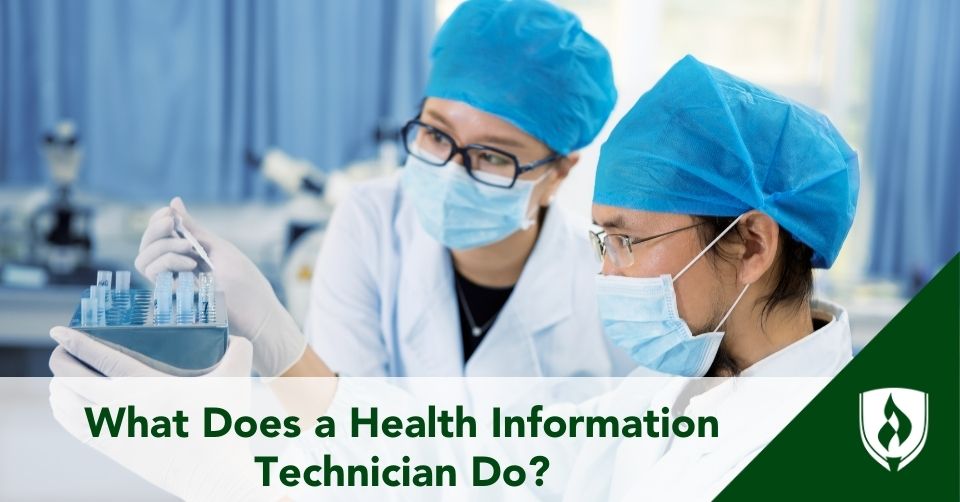What Does a Health Information Technician Do?
05/01/2025

Health information technicians (HITs) play a key role in managing patient data, ensuring the accuracy and security of medical records, and supporting healthcare providers in delivering effective patient care.
As technology has evolved with digital health records, HITs are important in managing electronic health records (EHRs) and maintaining patient medical records in healthcare facilities. Explore typical job responsibilities for health information technicians and how they support the healthcare ecosystem.
Role of a Health Information Technician
Health information technicians are primarily responsible for managing and safeguarding patient data1, so that it’s accurate, complete, and secure. They work with electronic health records systems to handle medical records in a digital format. Technicians ensure medical records are accessible to healthcare professionals, assisting in clinical databases, data entry, and quality control.
One of the primary responsibilities of health information technicians is to ensure compliance with regulations such as HIPAA (Health Insurance Portability and Accountability Act), which protects patient privacy. By adhering to privacy laws and ethical standards, they ensure the confidentiality of patient information and that only authorized personnel can access sensitive data.
Health information technicians often collaborate with medical coders, health information professionals, and other specialists to keep data flowing smoothly in healthcare systems.
History and Evolution of the Profession
The role of health information technicians emerged in response to the increasing reliance on electronic medical records systems in healthcare2. The transition from paper records to digital systems3 led to the establishment of organizations like the Office of the National Coordinator for Health Information Technology (ONC)4 in 2004. This agency was instrumental in shaping the health information management field by promoting health informatics and helping healthcare facilities transition to electronic health records.
As healthcare providers transitioned to digital formats, health information technology (HIT) became vital for improving patient outcomes, ensuring data accuracy, and enhancing the efficiency of healthcare services. Today, health information technologists are responsible for managing patient records across a wide range of settings, from hospital settings to insurance companies and government agencies.
Key Responsibilities of Health Information Technicians
Health information technicians handle a variety of tasks that support the healthcare system. Some of their key duties1 include:
- Handling Medical Records: Health information technicians are responsible for organizing and reviewing medical records, ensuring that clinical codes are assigned correctly and that data is accurate. They also manage patient medical records to support insurance reimbursement and legal purposes.
- Coding Patient Information: Medical coders assign clinical codes to patient treatments, diagnoses, and medical procedures. Codes are used for billing, insurance reimbursement, and in electronic health records systems to ensure medical services are documented properly.
- Data Analysis and Management: Technicians work with clinical databases, analyzing patient information to identify trends, improve care quality, and support research. They make sure that data entry is completed accurately and that records are updated in real time.
- Administrative Support: Health information technicians work alongside healthcare providers and other medical professionals, providing administrative and support services, including record requests, managing medical records for hospital settings, and supporting patient care coordination.
- Compliance and Security: Ensuring the security of patients' health information is paramount. Health information technicians implement quality control measures, follow privacy regulations, and maintain the integrity of patient records, ensuring compliance with healthcare privacy laws.
A Day in the Life of a Health Information Technician
A typical day for a health information technician5 involves a mix of technical skills, administrative work, and collaboration with other healthcare professionals. They may start the day by reviewing medical terminology, updating electronic health records, and verifying that procedure codes and diagnoses are correctly recorded. Throughout the day, HITs might also work on coding patient information for insurance claims, clarifying diagnoses, or conducting data entry to ensure all patient records are accurate.
Health information technicians often interact with medical providers and medical professionals to clarify any discrepancies in medical records and ensure the completeness of patient files. They may also handle record requests, assist with insurance reimbursement, and ensure that all medical information is coded for standardized codes in clinical databases.
Important Skills and Qualities of Health Information Technicians
Several skills are essential6 for health information technicians:
- Technical Skills: Proficiency with electronic medical records systems, coding systems, and health information technology is critical. HIT professionals must be comfortable working with information technology and managing clinical databases.
- Analytical Skills: Health information technicians must have a strong attention to detail to interpret and handle patient records, clinical codes, and medical data.
- Communication Skills: Effective interpersonal skills are necessary to collaborate with healthcare professionals, patients, and insurance companies. Technicians must clearly communicate complex medical terminology and ensure that patient care is not interrupted.
- Integrity and Confidentiality: A strong commitment to maintaining patient privacy and confidentiality is essential for this role, as health information technicians handle sensitive medical records.
Education and Training for Health Information Technicians
To become a health information technician, the typical educational requirements6 can vary. Some positions may require a bachelor's degree, while others can be entered with a high school diploma followed by specialized training or certifications or an associate degree. Medical terminology and a strong understanding of coding systems are important components of training.
Rasmussen University offers an online Health Information Technician Associate Degree7. Students in the program gain advanced skills in information policy, revenue cycle management, data management, healthcare technologies and more.
The program also offers students the opportunity to:
- Gain practical skills in virtual labs and a real work setting
- Use state-of-the-art health information technology and software
- Collaborate with experts in the healthcare profession
- Prepare for the American Health Information Management Association (AHIMA) Registered Health Information Technician (RHIT®) exam
- Seamlessly transfer into Rasmussen University's Health Information Management Bachelor’s degree
Career Outlook and Job Growth
According to the U.S. Bureau of Labor Statistics (BLS), the demand for HIT professionals is projected to grow by 16%8 from 2023 to 2033, which is much faster than average job growth. This is due to the increasing need for professionals who can manage and protect electronic health records, as well as handle medical records and clinical codes in healthcare facilities.
As healthcare services increasingly adopt health information technology and electronic medical records systems, health information technicians are likely to be needed in various healthcare settings, including government agencies, hospitals, and other healthcare facilities.
Career Paths and Specializations
Health information technicians can pursue various career paths, including:
- Health information technician9: Health information technicians organize and maintain medical records, ensuring accuracy and security while complying with regulations like HIPAA.
- Health information data collection and analysis specialist10: These specialists analyze patient data from electronic health records systems to improve patient care and operational efficiency.
- Medical coder / biller-analyst / auditor10: Medical coders assign clinical codes for diagnoses and treatments, while billers ensure accurate insurance reimbursement, and auditors verify compliance with coding standards.
- Patient care coordinator11: Patient care coordinators manage patient records, facilitate communication between healthcare professionals and patients, and ensure care plans are followed.
- Compliance auditor12: Compliance auditors review healthcare practices to ensure adherence to regulations like HIPAA and proper handling of patient data.
Resources for Professional Development
Health information technicians can benefit from joining a professional organization such as the American Health Information Management Association (AHIMA), which provides certification, networking opportunities, and resources for continuing education.
Staying current with advancements and current trends in health informatics, data analysis, and electronic health records systems is another way to learn the latest information in the field.
Taking the Next Step to Become a Health Information Technician
Health information technicians are at the forefront of managing patient medical records and patient data, ensuring the accuracy, security, and accessibility of health information.
With the rise of electronic health records and increasing demands for healthcare services, the role of health information technicians has never been more important.
If you're considering a career in health information technology, explore the path to pursuing an associate degree in HIT from Rasmussen University.
The Registered Health Information Technician (RHIT®) Exam is a registered trademark of the American Health Information Management Association (AHIMA). Copyright © 2020 AHIMA. All rights reserved.
Should a student need to take the exam more than once to receive a passing score, they will be responsible for all subsequent exam application fees.
1Bureau of Labor Statistics, U.S. Department of Labor, Occupational Outlook Handbook, Health Information Technologists and Medical Registrars, at https://www.bls.gov/ooh/healthcare/health-information-technologists-and-medical-registrars.htm#tab-2 (visited Mar. 11, 2025).
2National Center for Biotechnology Information, Article on Predictive Modeling in Healthcare, at https://pmc.ncbi.nlm.nih.gov/articles/PMC5171496/ (visited Mar. 11, 2025).
3Thieme Connect, "Health Informatics and Its Role in Healthcare," at https://www.thieme-connect.com/products/ejournals/pdf/10.15265/IYS-2016-s006.pdf (visited Mar. 11, 2025).
4ScienceDirect, "The Impact of Health Information Technology on Healthcare," at https://www.sciencedirect.com/science/article/abs/pii/S0196064415002863 (visited Mar. 11, 2025).
5Bureau of Labor Statistics, U.S. Department of Labor, Occupational Outlook Handbook, Health Information Technologists and Medical Registrars, at https://www.bls.gov/ooh/healthcare/health-information-technologists-and-medical-registrars.htm#tab-2 (visited Mar. 11, 2025).
6Bureau of Labor Statistics, U.S. Department of Labor, Occupational Outlook Handbook, Health Information Technologists and Medical Registrars, at https://www.bls.gov/ooh/healthcare/health-information-technologists-and-medical-registrars.htm#tab-4 (visited Mar. 11, 2025).
7Rasmussen University, "Health Information Management Degree Overview," at https://www.rasmussen.edu/degrees/health-sciences/health-information-management/hit-associates/ (visited Mar. 12, 2025).
8Bureau of Labor Statistics, U.S. Department of Labor, Occupational Outlook Handbook, Health Information Technologists and Medical Registrars, at https://www.bls.gov/ooh/healthcare/health-information-technologists-and-medical-registrars.htm#tab-6 (visited Mar. 12, 2025).
9Bureau of Labor Statistics, U.S. Department of Labor, Occupational Outlook Handbook, Health Information Technologists and Medical Registrars, at https://www.bls.gov/ooh/healthcare/health-information-technologists-and-medical-registrars.htm#tab-2 (visited Mar. 12, 2025).
10Bureau of Labor Statistics, U.S. Department of Labor, Occupational Outlook Handbook, Medical Records and Health Information Technicians, at https://www.bls.gov/ooh/healthcare/medical-records-and-health-information-technicians.htm#tab-2 (visited Mar. 12, 2025).
11Bureau of Labor Statistics, U.S. Department of Labor, Occupational Outlook Handbook, Medical and Health Services Managers, at https://www.bls.gov/ooh/management/medical-and-health-services-managers.htm#tab-2 (visited Mar. 12, 2025).
12Bureau of Labor Statistics, U.S. Department of Labor, Occupational Outlook Handbook, Accountants and Auditors, at https://www.bls.gov/ooh/business-and-financial/accountants-and-auditors.htm#tab-2 (visited Mar. 12, 2025).



